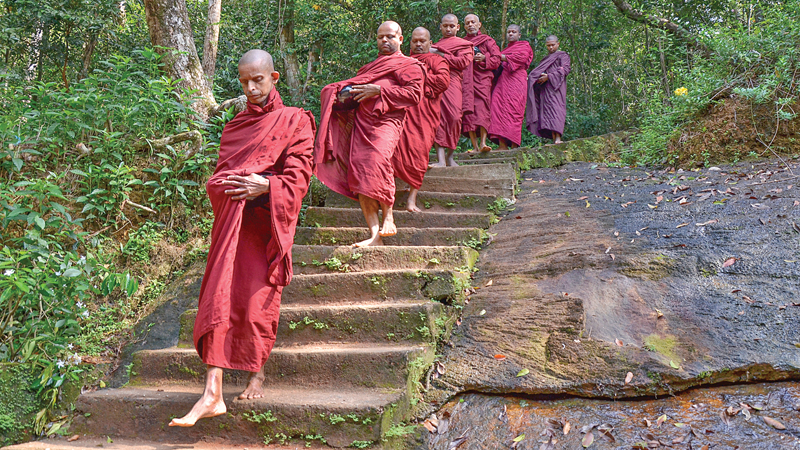 Seven monastic bhikkhus presented themselves for the midday ‘dana’. It was a rare sight to see them walk silently down the pathway on ‘pindapatha’ in keeping with tradition dating back to the days of the Buddha when bhikkhus went on alms round for their food.
Seven monastic bhikkhus presented themselves for the midday ‘dana’. It was a rare sight to see them walk silently down the pathway on ‘pindapatha’ in keeping with tradition dating back to the days of the Buddha when bhikkhus went on alms round for their food.
They came in a single file, one after the other, each carrying an alms bowl and patiently let the devotees serve the alms into their bowls. Once they were offered alms, they moved on and retired into the alms hall a little distance away and sat down to partake of the food.
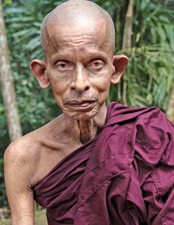
Ven. Rahula Thera
in front of his kuti
We were at the Bodhinagala forest hermitage, a few kilometres away from Ingiriya on the Panadura-Ratnapura road. To arrive at the hermitage, having turned left from Aduragala, we drove along a tarred road, certain sections of which were in a dilapidated condition. Having driven about three kilometres along this road, we parked our vehicle at a nearby house close to the hermitage.
A rugged pathway led us on a steady climb through the forest, the greenery all around providing a cool canopy. It was a hot sunny morning, yet the shade protected us from the heat. The serene undisturbed environment seemed ideal for meditation and the pathway led to the ‘kutis’ (cells) where monastic bhikkhus stay and meditate.
Each time I visited the hermitage in the 1980s, I used to see one bhikkhu, slender in build and fair in complexion, always walking in front of the group of bhikkhus when they moved towards the alms hall. During my recent visit to the hermitage, I decided to talk to this bhikkhu and find out more about his life.
Bhikkhu in old age
Now, the bhikkhu is too weak and has done away with most of his daily routine such as walking for pindapatha which is quite an arduous task, walking up and down of the stepped pathway. He stays at his kuti and only walks to the main alms hall and spends life leisurely. The devotees bring dana to the alms hall and offer to the bhikkhu.
Up a stone pathway is his kuti, furnished with a narrow bed, a table and a low stool. The walls are adorned with pictures of the Buddha. The kuti is surrounded by huge trees, which provide ample shade and a sense of absolute calm. The silence of this serene scene is occasionally broken by the sound of a grey-hornbill or a monkey.
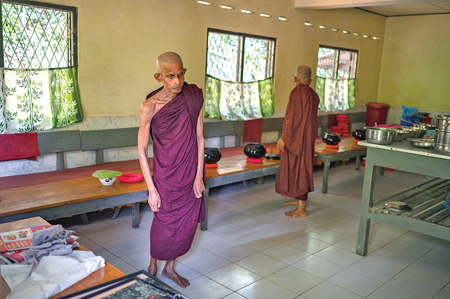
Ven. Rahula Thera at the alms hall
The bhikkhu, 78-year-old Ven. Thibbotugoda Rahula Thera, who has been living in the Bodhinagala forest hermitage since 1966, is the most senior resident of the hermitage. Welcoming me to his humble abode, he recounts the extraordinary story of journey to the hermitage and a life spent in meditation.
Born to a Buddhist farming family at Thibbotugoda, Horana in 1948, Somawardena Kaluarachchi, as he was then known, had his primary education at the Welikala Primary School in Pokunuwita. He then joined Sri Palee College, Horana, and continued till his Ordinary Level education. Being a small boy, he used to frequently visit his grandmother’s house next door, because of the plethora of books available there. Among the books he liked most to read were Jathaka stories.
Being the only son in a family of eight, his father gave everything to him. They had a number of acres of paddy lands, so they were fairly well to do. He went to school by a bullock-cart owned by his father.
He studied up to the Ordinary Level, and dropped out, opting to study the Buddhist doctrine and enter the bhikkhuhood. He had always associated with the village temple where he had learnt a lot about Buddhism.
Entering the bhikkhu order
“I began to read more Buddhist books soon and I found myself being interested in the forest hermitage in Ingiriya. One day, I visited the hermitage with my father and met the Chief bhikkhu. I told him I would like to enter the bhikkhuhood. My parents gave permission to me to be a bhikkhu,” once called Somawardena recalled, while sitting on a stone slab in front of his kuti.
His dreams were realised in 1966, when at the age of 19, he was ordained as Thibbotugoda Rahula under the guidance of Bodhinagala forest hermitage Chief Incumbent Ven. Olaboduwe Dammakirthi Thera. He lived at the hermitage as a samanera for several years, studying meditation practices with five other bhikkhus, before he obtained Upasampadha in 1971 at the Asgiriya Temple in Kandy.
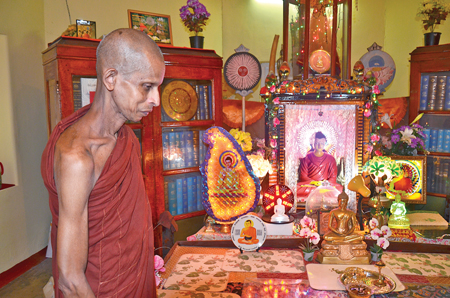
Ven. Rahula Thera practises ‘Buddha Watha’ at a shrine
“I became a bhikkhu of the hermitage soon. I was provided everything I wanted as a bhikkhu. Devotees gifted robes. My family members and relatives came to see me from time to time. Even today, my sisters who are old now, visit me regularly,” he said.
Since becoming a monastic bhikkhu, Ven. Rahula Thera has been following a timetable for daily routine for meditation, study and worship, which usually lasts until 10 p.m. Insight meditation practised usually sitting still lasts for one and a half to two hours twice a day. The daily program also includes a few domestic duties, with priority being given to cleanliness; the timetable includes a daily bath, which is a must unless indisposed.
In the past 60 years, Ven. Rahula Thera has spent his monastic life practising insight meditation, part of which is widely used Anapanasathi, the concentration on rhythmic inhalation and exhalation of breath. Though seemingly simplistic, this highly effective exercise hones consciousness and concentration to a fine edge, focusing the mind on an almost involuntary body function.
Daily routine
“My day starts at 4 a.m. At 6.00 a.m., I used to walk on Pindapatha for breakfast which I have stopped now due to my physical inability. I have a bath around 9.30 a.m. and get ready for Pindapatha for the midday meal, which is at 10.a.m at the alms hall. All the bhikkhus in the hermitage gather in the upper alms hall from where we walk on Pindapatha to the lower alms hall, which is a little distance away, where devotees offer alms to our begging bowls. We return to the upper alms hall and partake of our midday meal with all other bhikkhus. After dana, we rest for a little while and read the Dhamma books, which are gifts of the devotees,” he said, elaborating on the daily schedule which rarely varies.
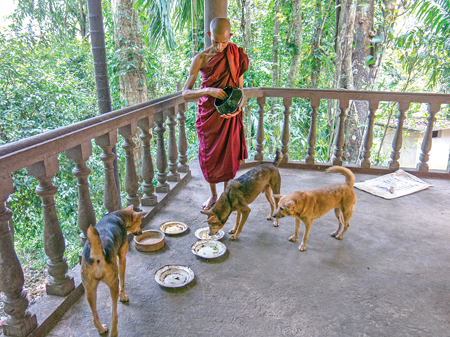
Ven. Rahula Thera feeds dogs at the hermitage
Ven. Rahula Thera has been in charge of the Dhamma Chetiya in the hermitage for several years. He is responsible for holding the daily Buddha Pooja. “Around 7.00 p.m., the devotees who come to offer alms the following day, take part in this Buddha pooja called ‘Buddha Watha’, which takes about one hour. After finishing the day’s work, I go to sleep around 10.00 p.m.,” he said.
Do the monastic bhikkhus ever venture into the outside world? Being Vipassanadhura bhikkhus, Ven. Rahula Thera said, he and his fellow bhikkhus are mainly in contemplation, and that with Vippassana Bhavana or insight meditation, being the dominant and central theme, they live mostly in secluded forest hermitage complexes call Aranya.
They do not take part in religious activities outside of the hermitage, but if someone invites them to deliver a sermon, they will accept it.







